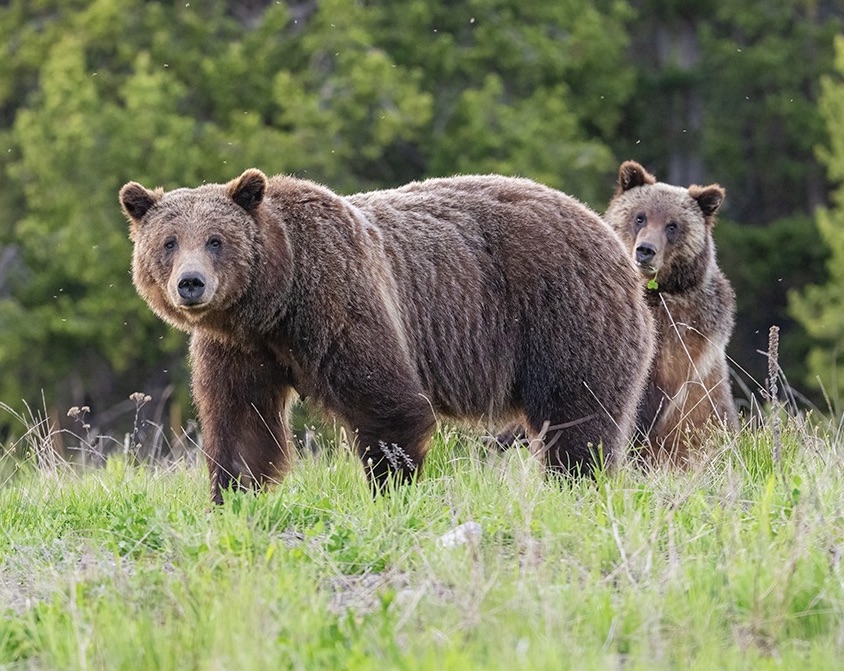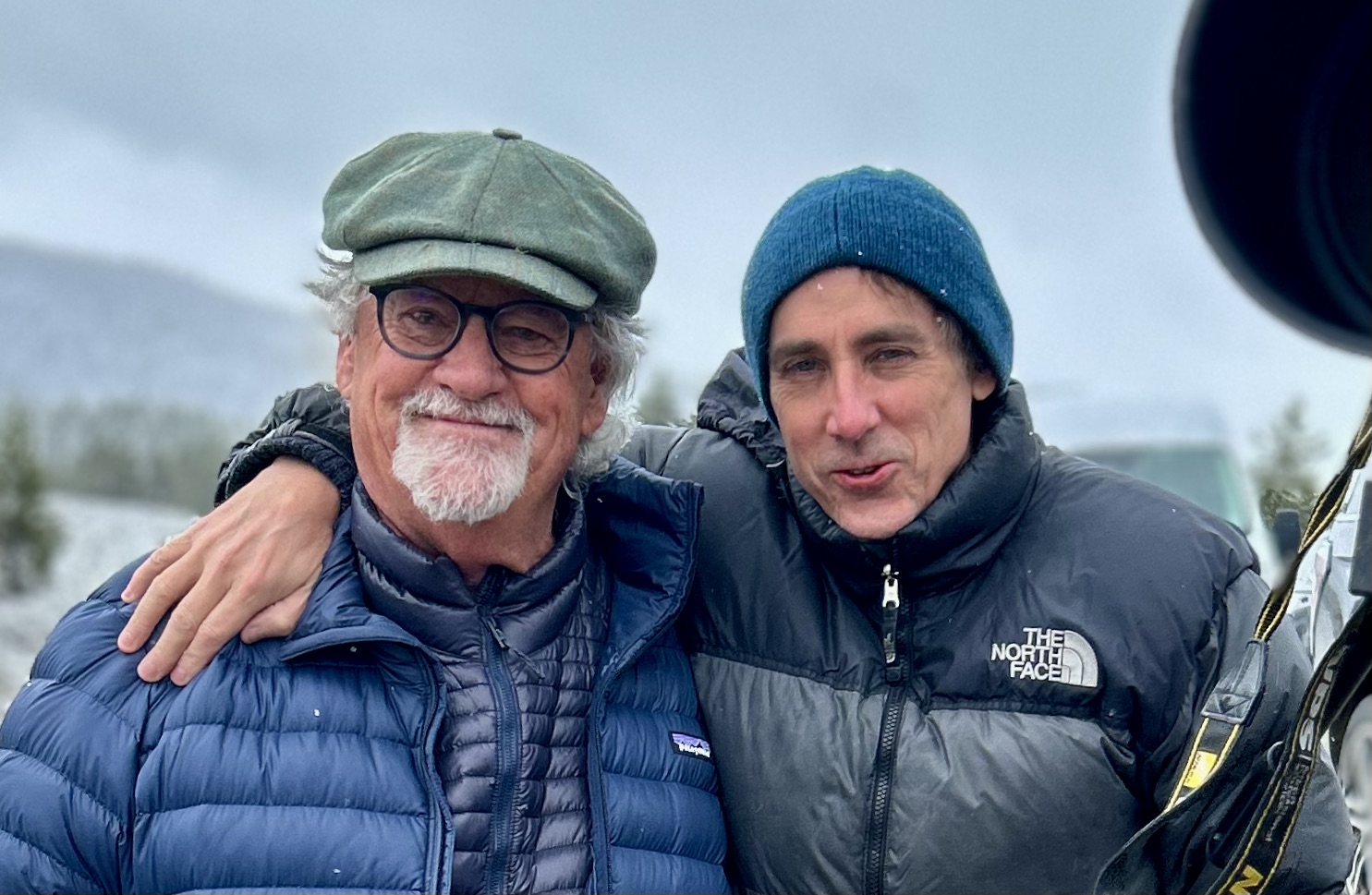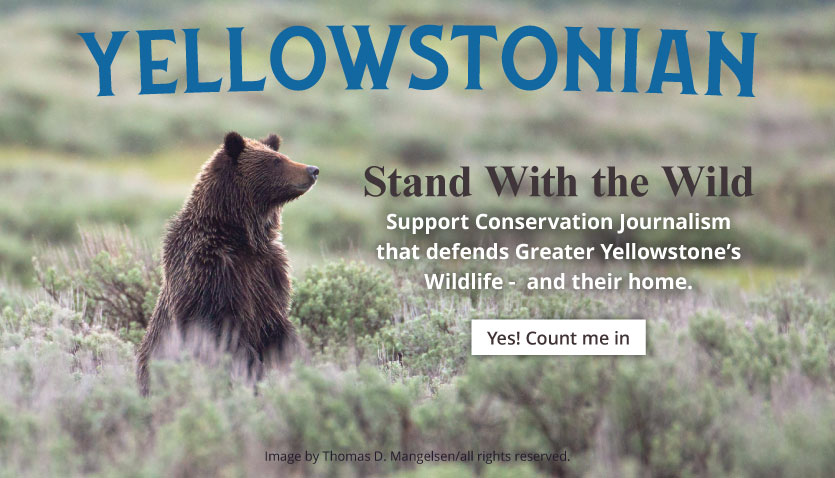by Thomas D. Mangelsen and Todd Wilkinson
That awful dreaded day arrived. Jackson Hole Grizzly 399 has left us. Her passing was inevitable and painful no matter what form it took. Now that it has happened in a most horrific way, there is the matter of how to move forward. In particular, how might we bring honor to her memory? How do we, who have been given so much by her, give back to members of her kind as an expression of gratitude?
Untold thousands of people around the world have posted tributes, left comments, shared memories and come together in mass expressions of grief at her loss. All this for a non-human being who touched something deep within us that’s too profound to adequately explain. But what is it?
The simple truth, inarguable and unignorable, is that 399 and her cubs generated a lot of heartfelt human goodwill, steadily accruing over a long time. She brought unprecedented clarity to the previously-amorphous purpose of grizzly bear conservation in the Lower 48. And, in putting a familiar face on it, she reminded Americans how, when this country chooses, it can be a bright beacon for saving species and showing why it matters.
Before 399 made her appearance in Jackson Hole, grizzly bears, except for a few viewed along the roadsides of Yellowstone to the north, were largely elusive, characterized as fearsomely temperamental, fleeting creatures, poorly understood and, mostly, as non-individuals that were hard to get to know. Grizzlies had been gone from the Tetons for decades.
399 forced us to confront our biases and ground-truth them against reality.
We will not dwell on the following points for very long, but they must be stated because they’re part of the history and they represent a backdrop for pondering next spring when, for the first time in 29 years, 399 will not be emerging from her den up Pilgrim Creek.
Now there is talk of what will happen to 399’s physical remains. Rumors are circulating. One is that she already has been skinned—her hide and skull separated from her body—with plans to have a taxidermist stuff her, and then have her put on public display somewhere for “education purposes.” This to us seems incredibly undignified, callous and tacky.
A sad reality is the states of Wyoming, Montana and Idaho still don’t seem to appreciate and don’t wish to understand the magnitude and potency of the groundswell that surrounded 399. It’s obvious they don’t fully grasp why there’s been such a mass cathartic level of grieving that has welled up with her passing. They don’t seem to get that 399 represented a game-changing breakthrough in how the modern public has overcome truly backward thinking about animals whose resumes seemed written by authors of childhood fairy tales.
We’ll never forget the day when we were together on a slope above Willow Flats watching 399 teach her first triplets how to hunt elk calves and contemplated producing a book. That foursome included the lone surviving cub, 610, who is approaching her 20th year and is a mother herself. A book, however, depended upon 399 providing years of revelation and evading danger.
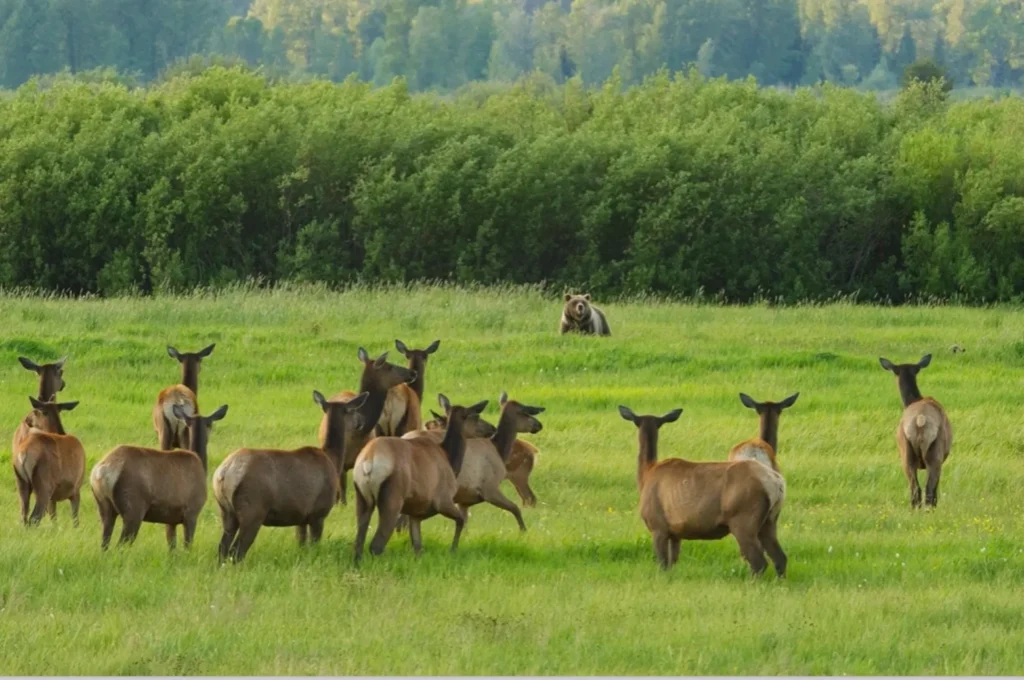
When we collaborated in telling 399’s story in pictures and words, it was not only to celebrate her and do her justice because she made it possible with her longevity and tolerant demeanor, but we did it because many of the culturally-prevailing narratives about grizzlies were troublesome and wrong.
Today, legislatures in some states have advocated banning books on various topics, including climate change, and it seems as if, where professional, science-driven, fact-based oversight of wildlife is concerned, years of progress are being replaced, metaphorically, with depictions of carnivores penned by the Brothers Grimm.
One doesn’t need to look far to find evidence. Wyoming’s political leaders, from Gov. Mark Gordon on down to his former director of the Wyoming Game and Fish Department Brian Nesvik, have willfully refused to outlaw the abhorrent legal practice of running down wildlife with snowmobiles, and killing animals with the machines.
Pick your own words to describe it, but for both of us who grew up hunting and fishing and went through hunter safety courses, condoning such behavior doesn’t conform to any sense of honor, morality, ethics and respect for wildlife taught to us by upstanding people who served as our role models.
At two recent public events co-hosted by Yellowstonian and featuring retired former federal grizzly bear recovery coordinator Chris Servheen and Yellowstone Park’s former senior wolf biologist Doug Smith, Servheen invoked the famous quote from forerunning American ecologist Aldo Leopold. It is poignant and timely. “Ethical behavior,” Leopold wrote, “is doing the right thing when no one else is watching, even when doing the wrong thing is legal.”
Clearly, doing the right thing is outlawing running over wildlife with machines, and the wrong thing is allowing it to persist.
Grizzlies and wolves are not deities or demons, neither more or lesser than us; they are different than, but that doesn’t make them lesser in their ability to expand our minds and prompt us to engage in self reflection.
Wyoming’s overt hostility to carnivores speaks to a stubborn, defiant pathology. I [Wilkinson] have witnessed it firsthand, reporting on grizzly and wolf conservation for decades and then in writing a lot about 399 and cubs. States tell us they embrace bear recovery, but only begrudgingly in words and actions. They often behave as if they are being forced to do good things for grizzlies against their will.
Along with Montana and Idaho, Wyoming didn’t like it when bears were given federal protection in 1975, and sport hunting of bears was prohibited. They’re still resentful today, but consider this: the odds of a grizzly population having survived these last 50 years in Greater Yellowstone, or wolves ever having been brought back from annihilation without the Endangered Species Act, would have been nil if left to the states. That’s the assessment not of us, but of expert scientists who were on the ground, battling the political resistance
Ironically, despite their ongoing animosity toward these species, wildlife watching involving grizzlies and wolves alone generates far more tourism dollars today in a single year than the three states have spent combined on grizzly and wolf management in over half a century. They are major anchors to an annual $1.5 billion nature-tourism industry linked to Yellowstone and Grand Teton alone, and they are catalysts for 15,000 jobs.
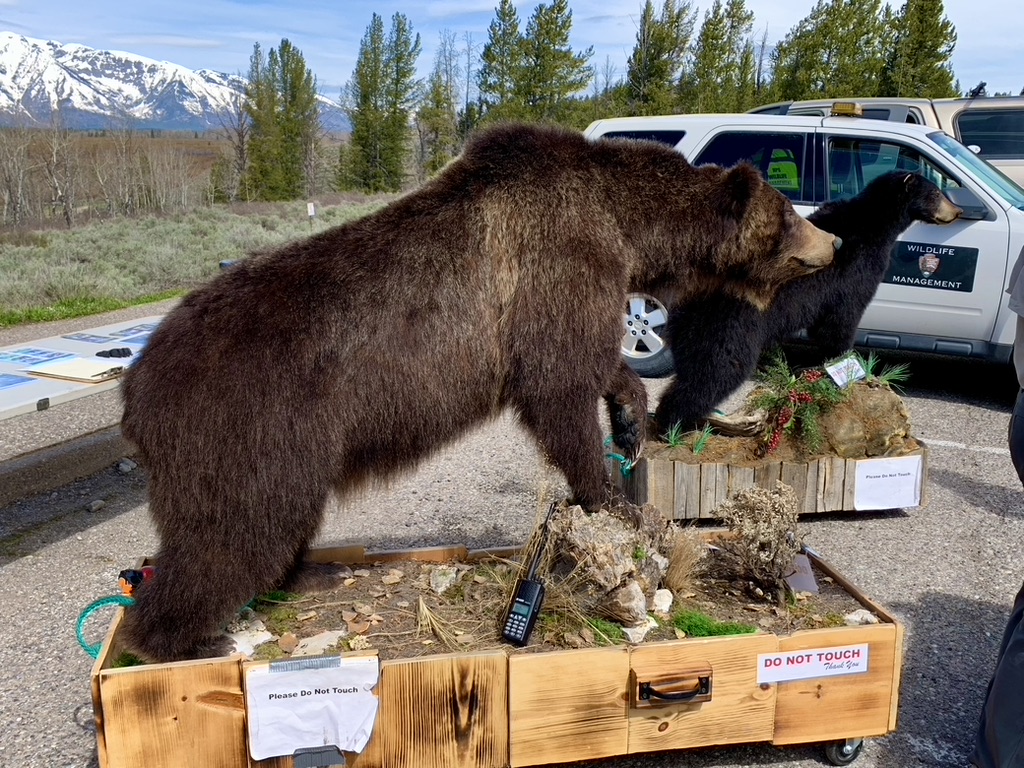
Now there is talk of what will happen to 399’s physical remains. Rumors are circulating. One is that she already has been skinned—her hide and skull separated from her body—with plans to have a taxidermist stuff her, and then have her put on public display somewhere for “education purposes.”
This to us seems incredibly undignified, callous and tacky. Treating her as if she were a specimen for a natural history museum display might have been appropriate in 1924, but today it would despoil the spirit of what 399 represented to so many millions around the world.
To be more blunt, it would be transforming her, in death, into a kind of trophy—the very thing 399’s millions of advocates wanted to prevent by opposing sport hunting bears for fun and the potential she would be targeted by an ego-driven cretin seeking bragging rights for taking the most famous living bear on Earth.
Bureaucrats proposing the taxidermy route may claim they are well intentioned, but it illustrates writ large a chasm that still exists between how some government officials think about wildlife and what 399 was as a touchstone for the general public. Language matters. It reveals how people think. Neither 399, her cubs or any grizzly is “a natural resource,” like old growth trees in a national forest whose “highest and best use”—per the perspective of “wise use” advocates— is being turned into useable board feet of timber.
We’ve heard some people who work for the agencies assert time and again that they “only manage for populations,” not individual animals. Some of them, in trying to justify the return of sport hunting seasons for grizzlies, have made references to setting killing quotas based upon “the production of surplus bears that can be sustainably harvested.” This is the lexicon farmers use to discuss crop yields, and in looking upon bushels of wheat or ears of corn, and it demonstrates the inability of some wildlife managers to appreciate 399 and other non-humans as individual sentient beings, each one unique.
Some of them, in trying to justify the return of sport hunting seasons for grizzlies, have made references to setting killing quotas based upon “the production of surplus bears that can be sustainably harvested.” This is the lexicon farmers use to discuss crop yields, and in looking upon bushels of wheat or ears of corn, and it demonstrates the inability of some wildlife managers to appreciate 399 and other non-humans as individual sentient beings, each one unique.
One question worthy of them pondering is this: do they think 399’s orphaned yearling cub “Spirit” was untraumatized after seeing her mother struck and killed by a car? Do they think the young wolf chased down by a snowmobiler, critically injured and then taken to a bar with duct-taped wrapped around its muzzle before being killed, did not experience what we would call deliberate infliction of suffering?
Let us not forget that when 399 lost a different cub, “Snowy,” to a hit and run driver in Grand Teton National Park in June 2016, she as any mother would, bawled and acted frantically, dragging Snowy’s body off the pavement and then sitting with it, desperately waiting for her offspring to wake up.
Bears and wolves are not brainless automatons. They possess emotions and intelligence, feel loss, suffer pain, and have individual personalities that, as 399 showed, resonate with humans. Individual bears and their stories matter. As a photographer these last 17 years, I [Mangelsen] witnessed it constantly and I encountered countless people who told me that seeing 399 and cubs was a highlight of their lives.
None of that magic translates if 399 becomes a stuffed bear fitted with fake glass eyes.
Millions of people let 399 into their hearts and minds and were inspired to count themselves as her advocates. That’s why they are mourning. She represented something relatably good in a world full of toxicity and divisiveness. The idea that she or one of her cubs could possibly wander beyond the protected boundaries of Grand Teton Park and get shot by a hunter wanting to singly possess her or other bears in death with a tag was, to many more than not, repugnant. As Dr. Jane Goodall said, the notion that anyone would want to turn 399 into a ghoulish prize as either a floor rug or head mounted on the wall was abominable.
Purely objectively, let us turn to the subject of delisting, or removing grizzlies from federal protection under the Endangered Species Act and handing management over to the states. At this moment there is a push being made by politicians to legislatively force delisting and Wyoming has made it clear that it wants to resurrect sport hunting.
Lacking is a cogent clear explanation of why grizzlies need to be hunted. Experts say there is no compelling biological reasoning, nor is there evidence it would result in fewer conflicts, reduce human injuries, or result in greater public respect in the local states for bears.
Normally, wildlife falls under the jurisdiction of states, unless a species is federally protected and under those circumstances it belongs to all American citizens and indeed killing such species can be a federal crime. If delisting happens, the decision of whether bears will be hunted will fall to just a handful of individuals—governors and the people they hand select to serve on their respective wildlife commissions. In all three states, the existing governors and their wildlife commissioners (some of whom have no expertise in professional wildlife management or sympathy for carnivores) will implement policy.
Now, consider this: between the three states, legislatures have passed bills and governors have signed them allowing hunters to set out baits to lure in black bears, hounds people can chase black bears with dogs, snares and traps can be set out for wolves in places where there are grizzly mothers with cubs. All of these things, says former federal grizzly bear recovery coordinator Servheen shows that the states are not taking ongoing recovery of grizzlies seriously because those activities will result in a lot more dead grizzlies—on top of mortality already being caused by clashes with hunters over carcasses, roadkills, removals for bears getting into human garbage and the rapid suburbanization of private landscapes that result in more people wanting bears removed.
The states say “just trust us,” but Servheen and many others say the actions above, combined with states defiantly refusing to outlaw the practice of running down wildlife with snowmobiles, gives the American public that has invested much in grizzly recovery little reason to do so.
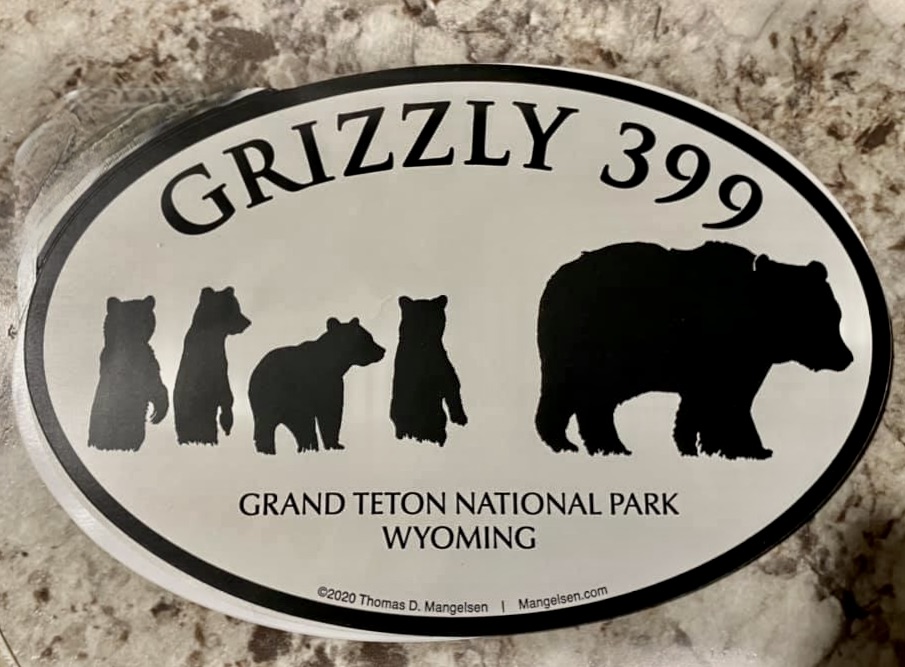
Regarding 399 and bears in Jackson Hole, recent superintendents, staff and wildlife brigade members in Grand Teton National Park deserve our praise for displaying compassion. And similar sentiments are extended to a few people with Wyoming Game and Fish who tried to find 399 and cubs accommodation in recent years as they set out on long walkabouts through even developed areas of Jackson Hole. Local politicians and non-governmental groups also have pushed to distribute bear-proof trash cans widely.
But lack of empathy for 399 was also expressed over the years in numerous other ways. Some disparaged her as a human-created “celebrity bear”—as if all the intention fawned on her was a personal fault that somehow diminished her stature. Some referenced her and other roadside bears as nuisances and inconveniences for managers— that it would be far better if bruins were pelted with rubber bullets and cracker shells and subjected to aversive conditioning so they would be afraid of people, fleeing the roadsides and running into the forest disappearing, out of sight and mind.
Had those techniques been applied to 399, and had she not capitulated, she might have been labeled a “problem bear” and then removed. Wyoming officials have said they intend to give hunters an opportunity to help them “harvest” “problem bears.” Most problem bears, so-called, are created by humans and Wyoming is lax not only in cracking down on people who feed wildlife but state legislators have undermined local efforts to deal with planning and zoning to slow the loss of rural habitat to sprawl.
Some referenced her and other roadside bears as nuisances and inconveniences for managers— that it would be far better if bruins were pelted with rubber bullets and cracker shells and subjected to aversive conditioning so they would be afraid of people, fleeing the roadsides and running into the forest disappearing, out of sight and mind. Had those techniques been applied to 399, and had she not capitulated, she might have been labeled a “problem bear” and then removed.
Of course, the very fact that 399 was visually accessible and demonstrated that grizzlies are not bloodthirsty menaces is what shattered the negative mythological portrayals of them. Mythological portrayals that, for generations, were used by livestock operators and their attendant politicians as justification to kill predators and nearly wipe them from the map of the West.
Grizzlies can be dangerous, especially mothers protecting their young against surprise perceived threats, no question, (just as humans can and are), but co-existence with bears is possible when we respect them, give them space, take time to understand them better, and safeguard their habitat.
It’s disappointing that a succession of Wyoming governors (whose tenures overlapped with 399’s lifespan) could never allow themselves to effusively embrace 399 [probably out of fear of backlash from carnivore-despising special interests]. Indeed, this may be why political leaders lack the courage to seize the moral and ethical high ground on the wolf and snowmobile issue.
Worth noting is that after our first book, “Grizzlies of Pilgrim Creek” was published, Interior Secretaries Ryan Zinke and Ken Salazar had it on the table in the main waiting room to their offices in Washington DC. Zinke, a Montanan, and a Republican, and Salazar, a Coloradan and a Democrat, understood how grizzlies were symbols of the wild West.
It’s heartbreaking to know how 399 died and we hope no enmity will be directed to the driver whose vehicle struck her. As many people know, I [Mangelsen] have long been vocal about the speed and inattentiveness of motorists traveling the highways of our wildlife-rich region, especially the roads of Grand Teton Park. It is a miracle we didn’t lose 610 in 2023 after she was injured when a vehicle collided with her on Highway 26 and, further, that none of her cubs died. Greater Yellowstone is a special place and living in it, visiting it or traveling through it requires having a special sensitivity. 399 was an expression of why it stands apart.
In our humble opinion and those of others, the best place for 399 to reside now is in the limitless confines of our imagination because she was, and is, larger than life. We hope the idea to have her stuffed is rejected. She ought to be laid to rest in a discreet unmarked location where her physical manifestation can be returned to the wild Earth, or cremated and her ashes scattered around Pilgrim Creek, her ancestral home. That would be poetic and graceful.
The dramatic elements that converged to create 399’s story were once in a human lifetime. They will never happen again or in quite the same way. She gave us a wake up call when we most needed it. Ironically, as we say goodbye to 399, let us not forget that this year we are rapidly approaching a record one for dead bears, the majority caused by human-related factors. Let us also remember that of 399’s 18 cubs, half have already died, most from non-natural causes.
Grizzly bears in Greater Yellowstone are facing threats that not only will never go away but every trendline indicates they will intensify.
We think it fitting to have a proper permanent marker memorializing her—perhaps a bronze statue—with an epitaph that explains her legacy as a mother and how she transformed the way we think about her species. We can think of no better tribute than recommitting ourselves to grizzly conservation, protecting what bears need to survive, and advancing true biological recovery that respects them as beings who add much to our world.
POSTNOTE 1: After listening to a large outpouring of 399 advocates who asked that she be cremated instead of turned over to a taxidermist, Hilary Cooley, national grizzly bear recovery coordinator for the US Fish and Wildlife Service, and Chip Jenkins, superintendent of Grand Teton National Park responded on Friday, November 1 with a press release. They announced that 399 had been cremated and her ashes spread in the Pilgrim Creek drainage where she was born and where she had given birth to 18 cubs across the span of her 28 years. Read the Yellowtonian story about the press release. Yellowstonian believes Cooley, Jenkins and their staffs deserve praise.
POSTNOTE 2 : State legislators, governors and some employees of wildlife agencies in Wyoming, Montana and Idaho often deny that their policies are having, and will have, negative consequences on grizzlies. For example, they claim that allowing trapping and snaring for wolves and other animals in known grizzly bear range will have benign effects. In the photos by Lisa Robertson and video, below, taken by Jeramey Hutchison the last week of October 2024 in northwest Wyoming, a grizzly bear mother—(not Grizzly 399 or 610)— believed to have lost part of her front right paw after getting caught in a large conibear trap, swats at ravens trying to eat from a carcass providing sustenance to the bruin mother and her cubs. Bear experts say that trapping, spring baiting for black bears and allowing hounds to chase black bears and mountain lions in grizzly bear habitat poses a serious threat to grizzly health and potentially human safety. Grizzly advocates ask: why are state wildlife commissioners so resistant to passing laws that advance grizzly recovery and do not jeopardize it?
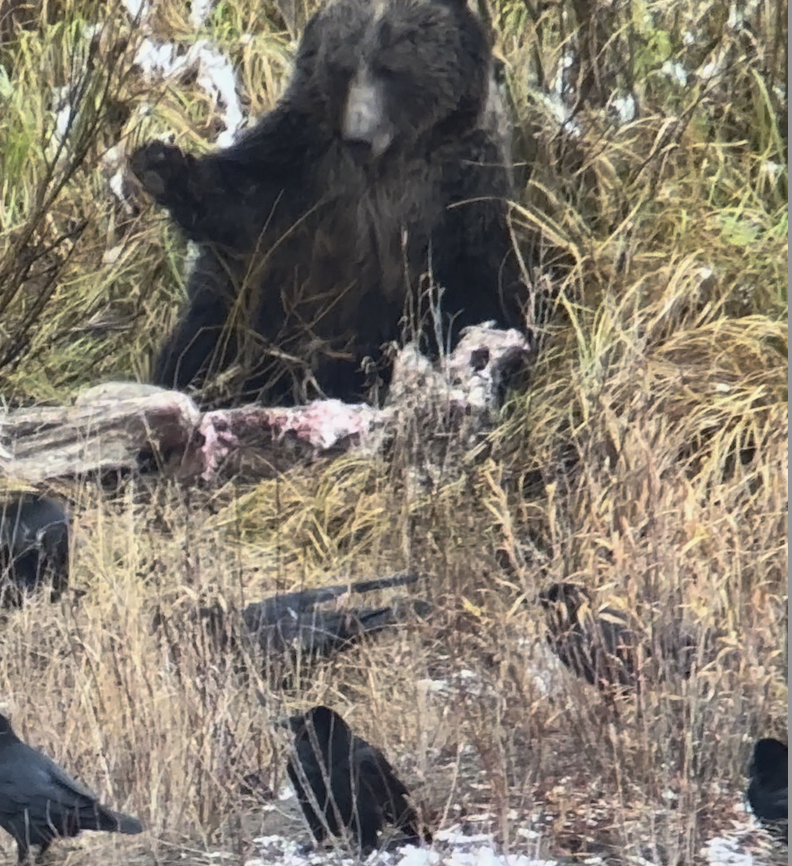
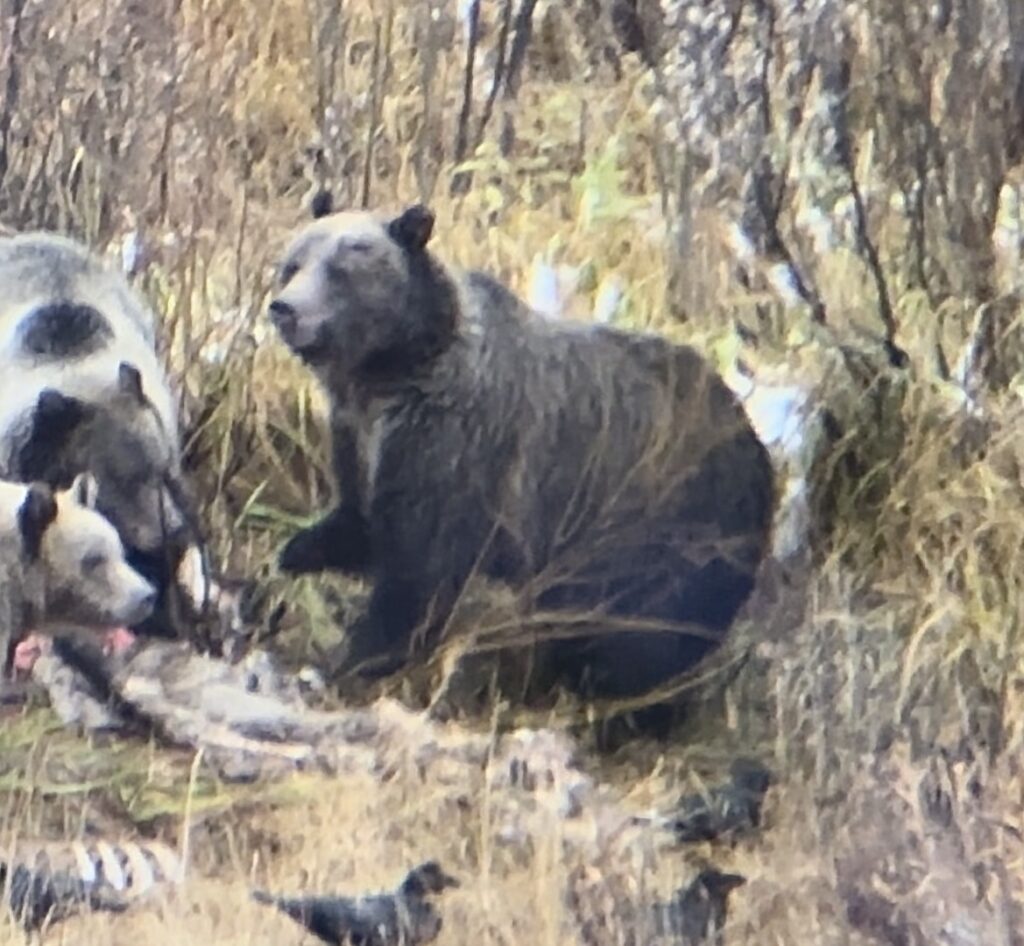
NOTE: Also read
Jackson Hole Grizzly 399 Is Back As A 28-Year-Old Mother
Will Two Of The World’s Greatest Wildlife Conservation Success Stories Be Unwritten?
Do Bald Eagles Provide A Way Forward For Achieving US Grizzly Bear Recovery?

